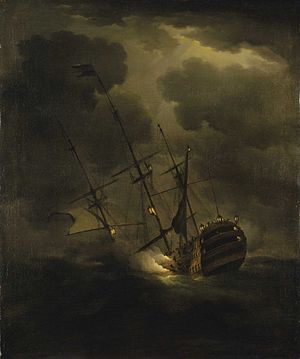HMS Victory (1737)

'Loss of HMS 'Victory', 4 October 1744' by Peter Monamy
|
|
| History | |
|---|---|
|
|
|
| Name: | HMS Victory |
| Ordered: | 11 September 1733 |
| Builder: | Portsmouth Dockyard |
| Laid down: | 1726 |
| Launched: | 23 February 1737 |
| Fate: | Wrecked, 4/5 October 1744 |
| General characteristics | |
| Class and type: | 1733 proposals 100-gun first rate ship of the line |
| Tons burthen: | 1921 bm |
| Length: | 174 ft (53 m) gundeck |
| Beam: | 50 ft (15 m) |
| Draught: | 18 ft (5.5 m) |
| Depth of hold: | 20 ft 6 in (6.25 m) |
| Sail plan: | Full rigged ship |
| Complement: | Around 900 |
| Armament: |
|
HMS Victory was a 100-gun first-rate ship of the line of the Royal Navy, built to the dimensions of the 1733 proposals of the 1719 Establishment at Portsmouth Dockyard, and launched on 23 February 1737.
A small number of the timbers used in the construction of Victory were taken from the remains of the previous HMS Victory, which had caught fire and been burnt to the waterline in February 1721 whilst having weed burned from her bottom (in a process called "breaming"). Officially a rebuild of the previous vessel, the new Victory was built by master shipwright Joseph Allin and cost £38,239 to assemble, plus £12,652 fitting as a flagship. Launched in 1737 she became the flagship of the Channel Fleet under Sir John Norris following completion in 1740. She was the last British First Rate to be armed entirely with bronze cannon.
The Victory was "a high-sided ship for her draught and this was believed to have made her leewardly and to have led to her loss". The term "leewardly" means she had a tendency to be pushed to leeward (down wind) more than normal when sailing with the wind on a quarter or on the beam, making her hard to keep on course. A plan of the ship reproduced in Howard and an extant contemporary model also show her with four rows of lights (stern galleries) and three quarter galleries, one more of each than was usual for an English three-decker in any period.
She was wrecked with the loss of her entire crew while returning to England as the flagship of Admiral Sir John Balchen after relieving Sir Charles Hardy, who had been blockaded in the Tagus estuary by the French Brest fleet. As the fleet reached the English Channel on 3 October 1744 it was scattered by a large storm. At around 15:30 on 4 October, the ships accompanying Victory lost sight of her near the Channel Islands. For over 260 years she was believed to have been wrecked during the night on Black Rock just off the Casquets, with the loss of her entire complement.
...
Wikipedia
